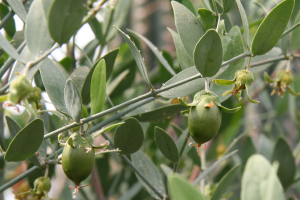Jojoba is a wind-pollinated plant, which indicates it may have existed before insects. There are distinct male and female plants and wind brings pollen to female flowers rather than bees. The seeds of the jojoba have many uses including food for both humans and animals, medicines and cosmetics.
Photo Credit: © Michael Wolf via Wikimedia Commons
Simmondsia chinensis
Common Name: jojoba
Plant Functional Group: Evergreen broadleaf
Class > Order > Family: Magnoliopsida > Caryophyllales > Simmondsiaceae
Where is the species found?
States & Provinces
AZ, CA, UT
Special Considerations for Observing
This species has separate male and female flowers. If you know whether the flowers you are observing are male or female (or both), please make a comment about it for that observation
Note that individuals of this species with only male flowers will not produce fruit.
Which phenophases should I observe?
Do you see...?
Leaves
Young leaves How many young leaves are present?
Less than 3 3 to 10 11 to 100 101 to 1,000 1,001 to 10,000 More than 10,000
Flowers
Flowers or flower buds More...
How many flowers and flower buds are present? For species in which individual flowers are clustered in flower heads, spikes or catkins (inflorescences), simply estimate the number of flower heads, spikes or catkins and not the number of individual flowers.
Less than 3 3 to 10 11 to 100 101 to 1,000 1,001 to 10,000 More than 10,000
Open flowers More...
What percentage of all fresh flowers (buds plus unopened plus open) on the plant are open? For species in which individual flowers are clustered in flower heads, spikes or catkins (inflorescences), estimate the percentage of all individual flowers that are open.
Less than 5% 5-24% 25-49% 50-74% 75-94% 95% or more
Fruits
Fruits Simmondsia chinensis , the fruit is a capsule that changes from green to light brown or red-brown and splits open to expose the seed, or drops from the plant before splitting. Do not include empty capsules that have already dropped their seeds.More...
How many fruits are present?
Less than 3 3 to 10 11 to 100 101 to 1,000 1,001 to 10,000 More than 10,000
Ripe fruits Simmondsia chinensis , a fruit is considered ripe when it has turned light brown or red-brown and has split open to expose the seed, or when it readily drops from the plant when touched. Do not include empty capsules that have already dropped their seeds.More...
What percentage of all fruits (unripe plus ripe) on the plant are ripe?
Less than 5% 5-24% 25-49% 50-74% 75-94% 95% or more
Recent fruit or seed drop More...
How many mature fruits have dropped seeds or have completely dropped or been removed from the plant since your last visit?
Less than 3 3 to 10 11 to 100 101 to 1,000 1,001 to 10,000 More than 10,000
What do these phenophases look like?
The following Phenophase Photo Guides for this species have been vetted for accuracy by the USA-NPN National Coordinating Office. Most photo guides are developed for a particular local or regional monitoring effort, and some of the content may not apply to your effort or your region. However, we make them available to provide as much help as they may in illustrating phenophases for this species. If you have high quality phenophase photos that you are willing to share with us, please visit the Phenophase Photo Guidelines page.
Be aware there is variation from individual to individual within a species, especially across different regions, so your plant may not look exactly like the one pictured.
Since they do not always include complete definitions for the species, use these photo guides ONLY in conjunction with the official Nature's Notebook phenophase defintions included in the table above, in the phenophase definition sheet that downloads with the datasheet, or in the Observe screen in the mobile app.
